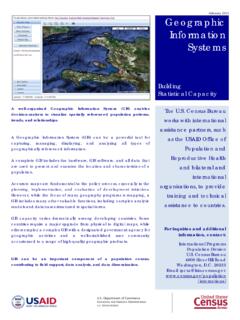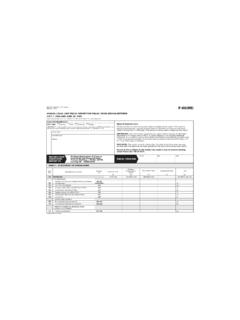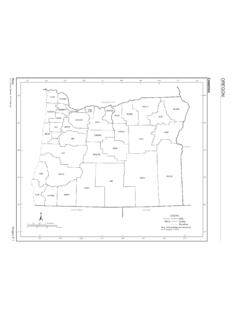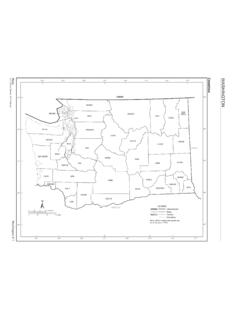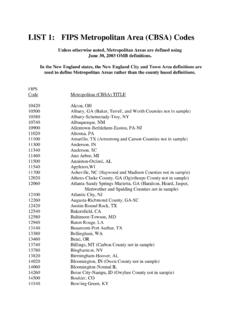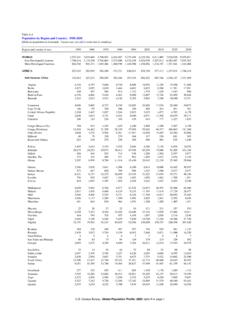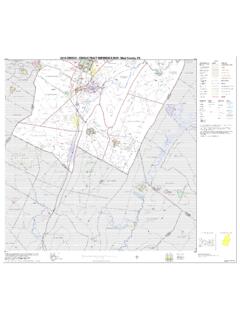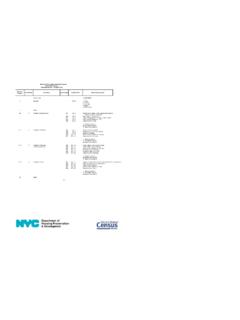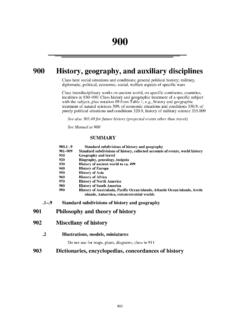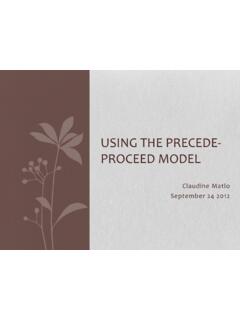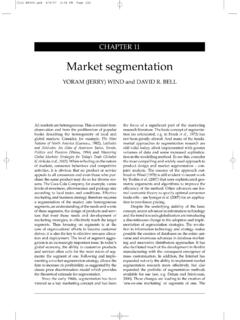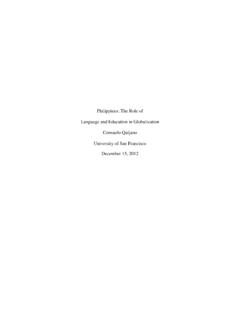Transcription of Chapter 14 Voting Districts - Census.gov
1 Voting district (VTD) is a generic term adopted by the Bureau of the Censusto include the wide variety of small polling areas, such as election Districts ,precincts, or wards, that State and local governments create for the purposeof administering elections. Some States also use groupings of these entities to define their State and local legislative Districts , as well as the Districts theydefine for election of members to the House of Representatives. In anationwide cooperative program for the 1980 census, the Census Bureaugave States the opportunity to request use of these election precinct bound-aries as the boundaries of census enumeration Districts (EDs) or, in someareas, census blocks. The Census Bureau began using the term Voting dis-trictsas it began planning for the 1990 census. This Chapter describes theevents that led to the development of the VTD program for the 1980 and1990 censuses, and briefly explains the operations and procedures theCensus Bureau used to implement the many decades, the Census Bureau tabulated and published populationtotals for wards within certain incorporated places and some county sub-divisions, such as minor civil divisions (MCDs) or census county divisions(CCDs).
2 These municipalwards normally were composed of several adja-cent election precincts from which voters elected governmental officialssuch as aldermen and councilmen. Wards have a long tradition in Ameri-can census taking from the reporting of population totals by wards in a 1768 census of Philadelphia through the Census Bureau s publications of ward data after the 1960 census1and the 1970 Census Bureau also used the ward boundaries for census enumeration; a wardboundary often was the outer boundary for a group of EDs. The CensusBureau developed plans to report population data by wards following the 1980 census, but deferred the tabulations because of budgetary con-straints. During this time, it became apparent that wards had certain draw-backs for purposes of statistical analysis; as electoral subdivisions, their size and geographic composition varied widely, and since their bound-aries shifted frequently, they had limited usefulness for trend analysis.
3 InVoting Districts 14-1 Voting DistrictsBackgroundChapter 1414-2 Voting Districtsaddition, other programs offered by the Census Bureau, such as the 1980 Neighborhood Statistics Program and the 1980 Election Precinct Program,offered data for small areas in a variety of formats, thereby filling the needfor data that would have been provided at the ward need to provide data for political representation, as prescribed by theConstitution, remains the primary purpose for conducting the decennial cen-sus of population. The Supreme Court s one-person/one-vote decisionof 1964, and various subsequent rulings of the courts, have been instrumen-tal in providing census data aggregated for small geographic units. Beforethe one-person/one-vote ruling, most State authorities favored drawing orrevising congressional and State legislative Districts to coincide with legallydefined units such as counties, MCDs, and incorporated places.
4 These geo-graphic entities often are not demographically or statistically comparable,however. Consequently, the resulting Districts often had significant popula-tion imbalances. In addition, there were other problems associated with theselection of only governmental unit boundaries for redistricting. Richard described some of these problems in his book, Political Redistrictingand geographic theory :3 In the United States, representatives are elected at several levels of government, butthere is no simple hierarchy of Districts , only complex and overlapping systems. and presidential electors are elected at large from States, representativesfrom congressional Districts of about equal size (510,000 in 1980). Within States, sen-ators and representatives are elected to legislatures from a structure of Districts totallyunrelated to the congressional Districts .
5 In some States, like Mississippi, even districtsfor senate and house are unrelated. Again, the structure of county council or supervi-sor Districts is wholly independent of state legislative or congressional Districts . Finally,city council or school Districts are likely to overlap confusedly with all the precedingsystems and with each other. The only example of nesting or hierarchy of governmen-tal units in the United States are councils of government (COGs) which are not directlyelected, but consist of members elected from constituent city, county, or special dis-trict geographic problem as such was historically not very profound or population was not viewed as having to be very equal, there was a tendencyto use simple existing boundaries of familiar legal territories, such as city limits, andmerely group these in convenient ways.
6 There was also a need to define voter pre-cincts, the finest subdivision of Districts . This was not always done on a clear basisVoting Districts 14-3of mutually exclusive territory. Even in the 1970s, precincts in some Mississippi coun-ties were places such as schools or fire stations, at which eligible citizens in thecounty could register and geographic problem has become much more complex and technically difficult,if not profound, in recent years because of court requirements of precise populationequality. Similar court requirements relate to treatment of racial minorities and con-cern with such matters as contiguity of territory and compact shape. The need forpopulation equality has led to questioning the use of precincts as building they rarely coincide with census enumeration areas, adequate populationdata for them is lacking.
7 In planning for the 1980 census, the Census Bureau focused on tryingto improve the usefulness of its data for precincts by providing programsdesigned to allow census enumeration area boundaries to coincide withprecincts, thereby making census data for precincts more readily availableto data users. To do this, the Census Bureau first had to evaluate the 1970programs, data, and data products relevant to election precincts, and thendevelop recommendations based on surveys of interested data Election Precinct Program for the 1980 CensusEvaluating the Redistricting Data Program for 1970 After the 1970 census, the Census Bureau sent a copy of the Master Enu-meration district List (MEDList) and census maps to appropriate officials ineach State legislature for their use in redistricting. The MEDList includedall 1970 EDs and block groups (BGs) by State, county, MCD or CCD, place,and census tract or block numbering area (BNA); the MEDList also pro-vided the population and housing unit counts for each entity.
8 Many Statesexperienced problems in using the MEDList and maps in relation to theirelection or legislative areas because the boundaries of the census entitiesoften did not coincide with the State or local Voting district this and other deficiencies, the Census Bureau decided thattwo major goals for the 1980 census would be to improve, where possible,(1) the boundaries of its small-area geographic entities used for redistrict-ing decisions, and (2) its associated data and data Voting DistrictsThe Census Bureau s efforts to achieve this goal began in 1973 with theestablishment of a close working relationship with the National Conferenceof State Legislatures (NCSL) and its Reapportionment Task Force. The Cen-sus Bureau worked with this group to identify the specific weaknesses inthe 1970 census data for use in legislative redistricting, and to minimizethese weaknesses for 1980.
9 In 1974, the NCSL conducted a mail survey ofState legislative officials and legislative staff throughout the Nation to betterdefine the existing problems and elicit recommendations for Census Bureau also held discussions with the International City Man-agement Association, the National League of Cities, the Conferenceof Mayors, and the National Association of Counties about ways to obtainsimilar information from members of these organizations. During 1974 and1975, over 70 communities across the Nation organized a series of publichearings on the upcoming decennial census; as a result of these meetings,the Census Bureau was able to obtain additional suggestions for improvingits redistricting data products and associated geographic surveys and discussions resulted in focusing attention on three majorrecommendations: (1) the early release of data, (2) the geographic compat-ibility of census tabulation units with Voting Districts , and (3) the need forblock-by-block population counts for incorporated places.
10 For many States,the final census data often arrived too late to be of any use to them. Inother States, the timing of data publication may have been acceptable, butthe size and boundaries of some of the tabulation units, specifically EDs,were not. Because census tabulation units were not directly compatiblewith local Voting Districts , State authorities involved in redistricting couldonly approximate the population and characteristics of the areas they weredelineating. Many users who had been frustrated with the 1970 data anddata products felt that data for the smallest possible census geographicunit, the census block, should be available for more areas so that Stateand local governments could make more acceptable the Election Precinct Program for 1980In the fall of 1975, the Census Bureau agreed to develop and implementa program aimed at improving the geographic and data products fromVoting Districts 14-5the 1980 census for use in legislative redistricting.
